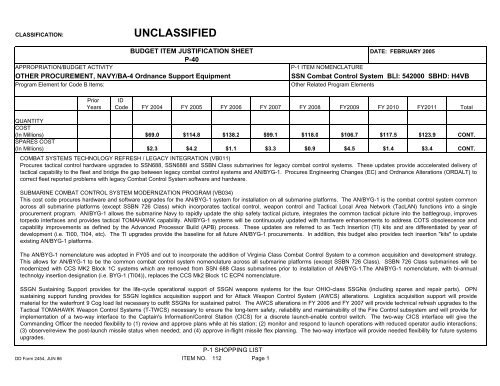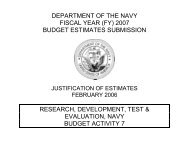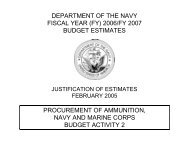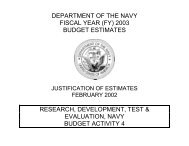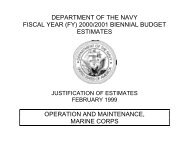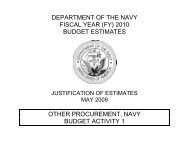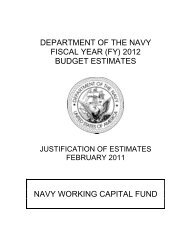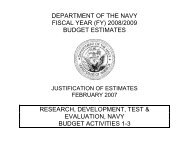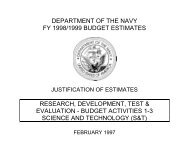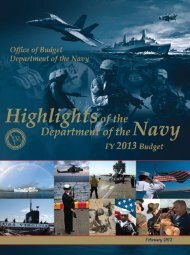Other Procurement, BA 4 - U.S. Navy
Other Procurement, BA 4 - U.S. Navy
Other Procurement, BA 4 - U.S. Navy
Create successful ePaper yourself
Turn your PDF publications into a flip-book with our unique Google optimized e-Paper software.
CLASSIFICATION:UNCLASSIFIEDBUDGET ITEM JUSTIFICATION SHEET DATE: FEBRUARY 2005P-40APPROPRIATION/BUDGET ACTIVITYP-1 ITEM NOMENCLATUREOTHER PROCUREMENT, NAVY/<strong>BA</strong>-4 Ordnance Support EquipmentSSN Combat Control System BLI: 542000 SBHD: H4VBProgram Element for Code B Items:<strong>Other</strong> Related Program ElementsPrior IDYears Code FY 2004 FY 2005 FY 2006 FY 2007 FY 2008 FY2009 FY 2010 FY2011 TotalQUANTITYCOST(In Millions) $69.0 $114.8 $138.2 $99.1 $118.0 $106.7 $117.5 $123.9 CONT.SPARES COST(In Millions) $2.3 $4.2 $1.1 $3.3 $0.9 $4.5 $1.4 $3.4 CONT.COM<strong>BA</strong>T SYSTEMS TECHNOLOGY REFRESH / LEGACY INTEGRATION (VB011)Procures tactical control hardware upgrades to SSN688, SSN688I and SSBN Class submarines for legacy combat control systems. These updates provide acccelerated delivery oftactical capability to the fleet and bridge the gap between legacy combat control systems and AN/BYG-1. Procures Engineering Changes (EC) and Ordnance Alterations (ORDALT) tocorrect fleet reported problems with legacy Combat Control System software and hardware.SUBMARINE COM<strong>BA</strong>T CONTROL SYSTEM MODERNIZATION PROGRAM (VB034)This cost code procures hardware and software upgrades for the AN/BYG-1 system for installation on all submarine platforms. The AN/BYG-1 is the combat control system commonacross all submarine platforms (except SSBN 726 Class) which incorporates tactical control, weapon control and Tactical Local Area Network (TacLAN) functions into a singleprocurement program. AN/BYG-1 allows the submarine <strong>Navy</strong> to rapidly update the ship safety tactical picture, integrates the common tactical picture into the battlegroup, improvestorpedo interfaces and provides tactical TOMAHAWK capability. AN/BYG-1 systems will be continuously updated with hardware enhancements to address COTS obsolescence andcapability improvements as defined by the Advanced Processor Build (APB) process. These updates are referred to as Tech Insertion (TI) kits and are differentiated by year ofdevelopment (i.e. TI00, TI04, etc). The TI upgrades provide the baseline for all future AN/BYG-1 procurements. In addition, this budget also provides tech insertion "kits" to updateexisting AN/BYG-1 platforms.The AN/BYG-1 nomenclature was adopted in FY05 and out to incorporate the addition of Virginia Class Combat Control System to a common acquisition and development strategy.This allows for AN/BYG-1 to be the common combat control system nomenclature across all submarine platforms (except SSBN 726 Class). SSBN 726 Class submarines will bemodernized with CCS MK2 Block 1C systems which are removed from SSN 688 Class submarines prior to installation of AN/BYG-1.The AN/BYG-1 nomenclature, with bi-annualtechnolgy insertion designation (i.e. BYG-1 (TI04)), replaces the CCS Mk2 Block 1C ECP4 nomenclature.SSGN Sustaining Support provides for the life-cycle operational support of SSGN weapons systems for the four OHIO-class SSGNs (including spares and repair parts). OPNsustaining support funding provides for SSGN logistics acquisition support and for Attack Weapon Control System (AWCS) alterations. Logistics acquisition support will providematerial for the waterfront 9 Cog load list necessary to outfit SSGNs for sustained patrol. The AWCS alterations in FY 2006 and FY 2007 will provide technical refresh upgrades to theTactical TOMAHAWK Weapon Control Systems (T-TWCS) necessary to ensure the long-term safety, reliability and maintainability of the Fire Control subsystem and will provide forimplementation of a two-way interface to the Captain's Information/Control Station (CICS) for a discrete launch-enable control switch. The two-way CICS interface will give theCommanding Officer the needed flexibility to (1) review and approve plans while at his station; (2) monitor and respond to launch operations with reduced operator audio interactions;(3) observe/review the post-launch missile status when needed; and (4) approve in-flight missile flex planning. The two-way interface will provide needed flexibility for future systemsupgrades.P-1 SHOPPING LISTDD Form 2454, JUN 86 ITEM NO. 112 Page 1


